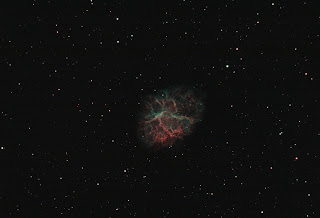RGB Composition of Dual Narrowband Images
 | ||
M1 the crab nebula in HaOIII, 40x90sec
|
 |
| M1 the crab nebula unfiltered RGB image, 40x60sec, C9.25 on EQ6-R Pro, ASI 294MC Pro |
It is interesting to look at and compare these pictures individually. However, I wanted to try combining them in a meaningful way. Basically I had five different "channels" - red, green, blue, Ha and OIII and was looking for good ways to compose an image from that. There are several ways for doing that, some more flexible than others. I ended up using Astro Pixel Processor (APP) using the following steps:
- register all raw images to align them
- stack and color correct the RGB images as usual
- stack the filtered images and create an Ha and an OIII image using corresponding function un APP
- use the APP function to remove stars on the Ha and OIII images
- adjust the histogram on the Ha and OIII images to make the background black
- use the RGB composition tool in APP to create various flavors of combined images
 |
| The RGB composition tool in APP the individual channels can be flexibly mapped to RGB and Luminance  Composite RGBHOO image |
 |
| NGC2350 "Thor’s Helmet", 25x120sec C9.25 on EQ6-R Pro, Reducer 1/6.3,ASI294MCPro, L-eXtreme |
 |
| NGC2350 "Thor’s Helmet", 25x90sec C9.25 on EQ6-R Pro, Reducer 1/6.3,ASI294MCPro |
 |
| Composite RGBHOO image of pictures above |


